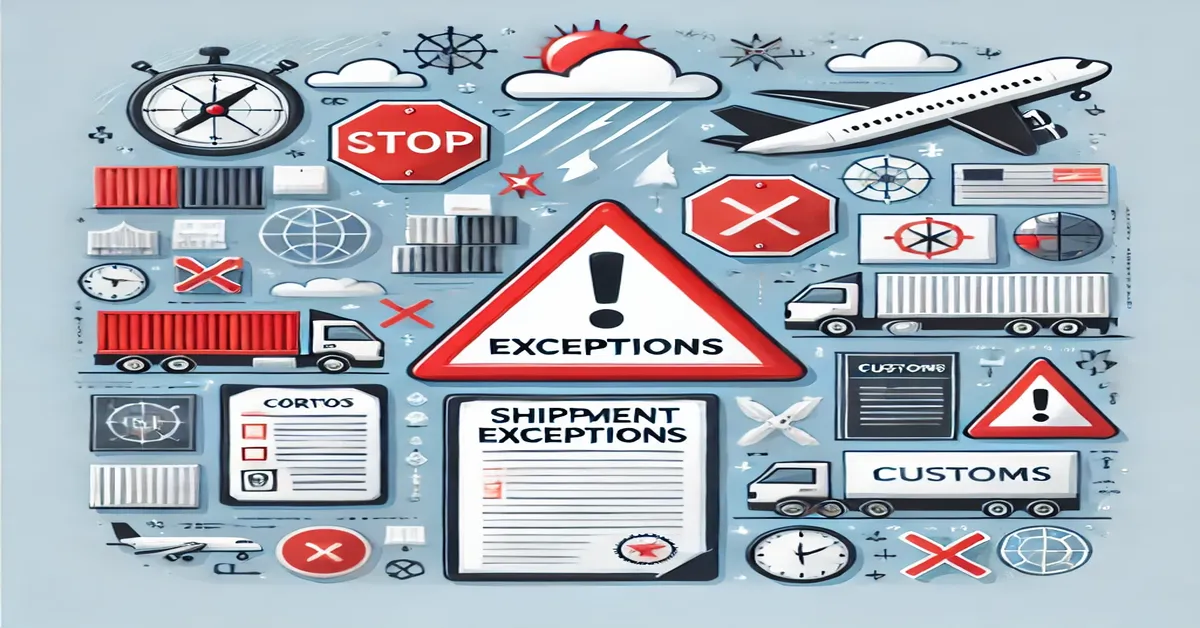In the world of logistics and supply chain management, ensuring timely and safe delivery of goods is paramount. However, even the most well-planned shipments can encounter unforeseen problems, known as shipment exception. These exceptions can disrupt the delivery timeline, cause customer dissatisfaction, and increase operational costs. Understanding shipment exceptions, their causes, and the best practices for handling them is essential for both businesses and customers. This comprehensive article will explore the concept of shipment exceptions, common causes, solutions, and how businesses can mitigate their impact.
What is a Shipment Exception?
A shipment exception occurs when a package encounters an unexpected event during transit that affects its timely delivery. This status update is usually flagged in the tracking system of the carrier, alerting the shipper and recipient that there is an issue. While not all shipment exceptions result in delays, they are red flags that something out of the ordinary has occurred.
Shipment exceptions can range from minor delays due to inclement weather to more severe issues such as lost or damaged packages. Each type of exception requires different levels of attention and response to resolve efficiently.
Common Types of Shipment Exceptions
Understanding the various types of shipment exception is the first step in addressing them. Below are some of the most common types of shipment exceptions:
- Weather-Related Delays Inclement weather is one of the most frequent causes of shipment exceptions. Snowstorms, hurricanes, heavy rain, and other adverse weather conditions can disrupt the transportation network, leading to delayed deliveries. While carriers often plan for seasonal weather patterns, unexpected severe weather events can throw even the most reliable delivery schedules off course.
- Customs Delays For international shipments, customs clearance can pose significant challenges. A package may be held up at customs due to incomplete or inaccurate documentation, unpaid duties, or random inspections. This type of shipment exception can result in considerable delays, especially if the required paperwork is not corrected promptly.
- Address Issues Address-related exceptions can occur if the shipping label has an incorrect, incomplete, or outdated address. Even minor errors such as missing apartment numbers or postal code discrepancies can prevent a package from being delivered on time. In such cases, the carrier may attempt to contact the sender or recipient to rectify the issue, which can cause delays.
- Failed Delivery Attempts A delivery exception can happen when a courier is unable to deliver the package because no one is available to receive it, the building is inaccessible, or the package requires a signature but the recipient is not present. After multiple failed delivery attempts, the package may be returned to the sender or held at a local facility for pickup.
- Damaged or Lost Packages Damage to a package can occur due to mishandling, poor packaging, or accidents during transit. When a package is damaged, it may be held by the carrier for inspection or returned to the sender. Similarly, lost packages can trigger a shipment exception, which often requires an investigation by the carrier.
- Mechanical Issues Transportation vehicles, including planes, trucks, and delivery vans, are subject to mechanical failures that can delay shipments. Whether due to a flat tire, engine breakdown, or other technical difficulties, mechanical issues can disrupt the supply chain and lead to shipment exceptions.
- Labor Strikes Labor disputes, strikes, or workforce shortages can create substantial delays in the delivery process. For example, a strike at a major port or among truck drivers can halt or significantly slow down shipments, affecting a wide range of industries.
How Shipment Exceptions Are Communicated
Shipment exceptions are typically communicated through tracking updates provided by the carrier. When an exception occurs, the tracking status will often change to reflect the nature of the issue, such as “Delivery Exception: Weather Delay” or “Held at Customs.” These updates help both the sender and recipient stay informed about potential delays and take appropriate action if needed.
Solutions for Handling Shipment Exceptions
When a shipment exception occurs, taking swift and appropriate action is crucial. Below are some solutions for effectively handling shipment exceptions:
- Proactive Communication Transparency and proactive communication are key when dealing with shipment exceptions. If an issue arises, carriers should notify both the sender and the recipient as soon as possible. This allows everyone involved to understand the problem and take necessary steps to minimize the impact.
- Providing Accurate and Complete Documentation For international shipments, ensuring that all documentation is accurate and complete can help avoid customs-related delays. This includes commercial invoices, packing lists, and any relevant import/export licenses. Double-checking the accuracy of this paperwork before shipping can save valuable time.
- Offering Multiple Delivery Attempts and Options In cases of failed delivery attempts, offering recipients flexible delivery options, such as scheduling a redelivery or opting for package pickup from a local facility, can help minimize disruptions.
- Insuring Shipments Insuring valuable shipments can provide a safety net in case of damage or loss. Shipment insurance helps cover the costs associated with lost or damaged items, ensuring that businesses do not suffer significant financial losses.
- Choosing Reliable Carriers Working with reputable carriers known for their reliability and efficient handling of exceptions can make a significant difference. These carriers often have robust systems and processes in place to address shipment exceptions quickly.
- Implementing Advanced Tracking Systems Leveraging advanced tracking technologies can help both businesses and customers stay informed about the status of their shipments. Real-time tracking systems can provide updates on location, estimated delivery time, and any exceptions that may have occurred, allowing for quicker responses.
Preventative Measures for Reducing Shipment Exceptions
While some exceptions are unavoidable, many can be mitigated with preventative measures. Here are some best practices for reducing the occurrence of shipment exceptions:
- Verify Shipping Information Double-checking shipping details, including the recipient’s name, address, and contact number, can reduce the chances of address-related exceptions. Automated systems that validate addresses before printing shipping labels can also be helpful.
- Pack Items Securely Ensuring that items are packaged securely can prevent damage during transit. Using appropriate packaging materials, such as bubble wrap, packing peanuts, and sturdy boxes, helps protect the contents from impacts and rough handling.
- Plan for Weather-Related Risks Anticipating weather disruptions and planning shipments accordingly can reduce delays. For example, shipping goods earlier during peak seasons or routing them through areas less affected by severe weather can help mitigate risks.
- Maintain Updated Documentation Keeping documentation up to date and accurate is crucial for international shipments. This includes reviewing trade regulations and customs requirements for the destination country to avoid unexpected delays.
- Utilize Shipment Tracking Tools Implementing tracking software that provides real-time updates and predictive analytics can help logistics teams identify potential problems before they escalate. With this information, businesses can take preemptive measures to address issues.
What to Do When a Shipment Exception Occurs
If a shipment exception occurs, here’s a step-by-step approach to handling the situation effectively:
- Identify the Nature of the Exception Review the tracking status to understand the type of exception and its cause. This information will guide the next steps and help determine the urgency of the response.
- Contact the Carrier If the tracking information does not provide enough detail or if immediate action is needed, contact the carrier directly for further clarification. Carriers often have customer service teams dedicated to handling shipment issues.
- Communicate with the Recipient Keep the recipient informed about the status of the shipment and any actions being taken to resolve the issue. Transparency can improve customer satisfaction and reduce frustration.
- Resolve Address Issues Quickly If the exception is due to an address problem, work with the carrier and recipient to correct the information as soon as possible. This may involve verifying the correct address or arranging for the package to be picked up at a local facility.
- File a Claim for Lost or Damaged Shipments If the shipment is lost or damaged, file a claim with the carrier to seek compensation. This process usually involves providing documentation such as the shipment invoice and a description of the lost or damaged items.
The Role of Technology in Managing Shipment Exceptions
Technology has become an invaluable tool for managing shipment exceptions. Advanced logistics software can automate many aspects of the shipment process, including tracking, documentation, and communication. Here’s how technology can help:
- Real-Time Alerts and Notifications Automated systems can send real-time alerts when a shipment exception occurs, allowing businesses to respond immediately. These alerts can be customized based on the type of exception, helping prioritize actions.
- Predictive Analytics Predictive analytics can be used to forecast potential issues before they arise. For example, analyzing weather patterns and traffic data can help businesses anticipate delays and reroute shipments proactively.
- Enhanced Communication Tools Digital communication platforms can facilitate seamless interaction between carriers, shippers, and recipients. These platforms can automate updates and provide all parties with the information needed to resolve issues.
- Streamlined Claim Processes Filing claims for lost or damaged shipments can be time-consuming, but technology can streamline the process. Many carriers now offer online portals where customers can submit claims and track











